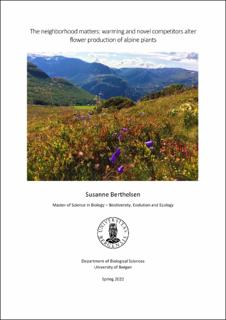| dc.description.abstract | Sexual reproduction, and the genetic variation it entails, could prove vital for plants’ ability to persist under a changing climate. Climate warming is causing species to shift their ranges to higher elevations and latitudes. The assembly of novel species combinations after asynchronous migrations with climate may have implications for the flower production of alpine plants. Studying how novel competitors affect flowering performance under climate warming is important to understand potential impacts of climate change on alpine plant population persistence and range dynamics. To investigate this, I used an established field experiment along a natural precipitation gradient in the mountains of western Norway, where both temperature and competitive conditions in alpine vegetation were manipulated through open-top chambers and transplant experiments. Data on flower production of graminoids and forbs in alpine plant communities and demographic data on two focal alpine species, Veronica alpina and Sibbaldia procumbens, were collected in four alpine semi-natural grasslands. In this study, experimental warming and the presence of novel competitors triggered higher flower production for graminoids and forbs, respectively. Additionally, the graminoid flowering community shifted towards more flowering in Cyperaceae- and Juncaceae species and less in Poaceae species under warming. Furthermore, fecundity clearly contributed to changes in population growth rates (∆λ) of both V. alpina and S. procumbens with warming and novel competitors. The population models revealed trade-offs in resource allocation between fecundity and vegetative growth and compensatory increases in fecundity with reduced survival. Thus, fecundity is strategically used in the ontogeny of alpine plant individuals. These findings suggest that genetic variation in alpine species will be preserved and that alpine plants may persist in alpine regions when influenced by the projected climate warming and range-expansion of lowland competitors, but also that the character of alpine grasslands may change towards more graminoid-dominant. | |
